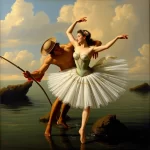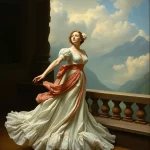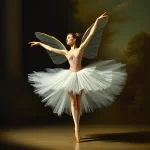Ballet: The Naiad and the Fisherman (Cesare Pugni, 1843)

Introduction
Ballet, an art form that combines music, dance, and storytelling, has produced numerous masterpieces over the centuries. One such gem is “The Naiad and the Fisherman,” a ballet composed by Cesare Pugni and choreographed by Jules Perrot. Premiered in 1843, this ballet weaves a tale of love, magic, and transformation, set against the backdrop of a mystical underwater world. The ballet’s enchanting narrative and captivating choreography have made it a beloved piece in the classical ballet repertoire.
Historical Background
Creation and Development
“The Naiad and the Fisherman” was created during a period of significant artistic and social change in Europe. The early 19th century saw the rise of Romanticism, a movement that emphasized emotion, nature, and the supernatural. This cultural shift influenced many art forms, including ballet. The inspiration for “The Naiad and the Fisherman” likely drew from various literary sources and folklore, which often featured themes of love and enchantment.
The collaboration between choreographer Jules Perrot and composer Cesare Pugni was instrumental in bringing this ballet to life. Perrot, a renowned dancer and choreographer, was known for his innovative and expressive choreography. Pugni, an accomplished composer, provided a rich and evocative score that complemented Perrot’s vision. Together, they created a ballet that seamlessly blended music and dance to tell a compelling story.
Premiere and Reception
“The Naiad and the Fisherman” premiered on March 12, 1843, at Her Majesty’s Theatre in London. The initial reception was overwhelmingly positive, with both critics and audiences praising the ballet’s enchanting story, beautiful music, and innovative choreography. Notable early performances included those by celebrated dancers such as Fanny Cerrito, who played the role of the Naiad, and Arthur Saint-Léon, who portrayed the Fisherman.
Synopsis of the Ballet
Act I Summary
The ballet opens with a picturesque fishing village by the sea. The Fisherman, a humble and kind-hearted young man, is introduced as he goes about his daily tasks. He is in love with a beautiful Naiad, a water nymph who lives in the nearby lake. Despite their different worlds, the Fisherman and the Naiad share a deep and abiding love.
Act II Summary
In the second act, the Naiad’s underwater realm is revealed. The Naiad longs to be with the Fisherman but is bound by the rules of her magical world. The Fisherman ventures into the lake to find her, encountering various mystical creatures and obstacles along the way. Their love is tested as they navigate the challenges of their different worlds.
Finale
The ballet concludes with a dramatic and emotional finale. The Naiad and the Fisherman must make a choice between their love and their respective worlds. In a poignant and magical resolution, the Naiad sacrifices her immortality to be with the Fisherman, transforming into a human. The ballet ends with their joyous reunion and a celebration of their love.
Musical Composition
Composer’s Role
Cesare Pugni, an Italian composer, played a crucial role in the success of “The Naiad and the Fisherman.” Pugni’s score is characterized by its lyrical melodies and rich orchestration, which enhance the ballet’s emotional depth and narrative. Notable pieces within the score include the Naiad’s solo, the Fisherman’s theme, and the dramatic music that accompanies their underwater journey.
Musical Themes and Motifs
The music of “The Naiad and the Fisherman” features several recurring themes and motifs that underscore the ballet’s narrative. The Naiad’s theme is ethereal and delicate, reflecting her otherworldly nature. The Fisherman’s theme is more grounded and robust, symbolizing his human qualities. These musical motifs are woven throughout the score, enhancing the emotional impact of the story.
Famous Recordings and Performances
Over the years, there have been several notable recordings and performances of Pugni’s score. These include recordings by renowned orchestras and performances by prestigious ballet companies. These interpretations have helped to keep the music of “The Naiad and the Fisherman” alive and accessible to new generations of audiences.
Choreography and Dance
Choreographer’s Vision
Jules Perrot’s choreography for “The Naiad and the Fisherman” is a testament to his innovative and expressive style. Perrot’s vision was to create a ballet that seamlessly blended narrative and dance, using movement to convey the emotions and struggles of the characters. His choreography is characterized by its fluidity, grace, and dramatic intensity.
Signature Dance Numbers
The ballet features several key dance numbers that are central to its narrative. These include the Pas de Deux between the Naiad and the Fisherman, which is a highlight of the ballet. This dance showcases their love and longing, with intricate lifts and expressive movements. Other notable scenes include the Naiad’s solo, which captures her ethereal beauty, and the ensemble dances of the mystical creatures in the underwater realm.
Notable Interpretations
Over the years, different productions of “The Naiad and the Fisherman” have interpreted Perrot’s choreography in various ways. Some have stayed true to the original choreography, while others have introduced new elements or modernized the movements. These interpretations reflect the evolving nature of ballet and the enduring appeal of this classic work.
Characters and Roles
Main Characters
- The Naiad: A beautiful water nymph who falls in love with the Fisherman. She is ethereal, graceful, and deeply emotional.
- The Fisherman: A humble and kind-hearted young man who loves the Naiad. He is brave, determined, and willing to face any challenge for their love.
Supporting Characters
- Village Folk: The inhabitants of the fishing village who provide a backdrop to the Fisherman’s life.
- Mystical Creatures: Various magical beings in the Naiad’s underwater realm who add to the ballet’s enchanting atmosphere.
Famous Dancers
Several renowned dancers have portrayed the roles of the Naiad and the Fisherman over the years. Fanny Cerrito and Arthur Saint-Léon were among the first to bring these characters to life. Their performances set a high standard for future interpretations and contributed to the ballet’s enduring legacy.
Cultural and Artistic Impact
Influence on Ballet and Dance
“The Naiad and the Fisherman” has had a significant influence on the world of ballet and dance. Its innovative choreography and emotive storytelling have inspired other works and choreographers. The ballet’s blend of narrative and dance has become a model for many subsequent ballets.
Cultural Significance
The ballet holds a special place in popular culture and has been referenced in various forms of media. Its themes of love and transformation resonate with audiences, making it a timeless story. The ballet has also been adapted into other art forms, including theater and film, further cementing its cultural significance.
Legacy and Revivals
“The Naiad and the Fisherman” continues to be performed and celebrated today. Major revivals and reinterpretations have kept the ballet fresh and relevant. Modern adaptations often incorporate new elements while staying true to the original spirit of the work. The ballet’s enduring popularity is a testament to its artistic and emotional power.
Iconic Productions
Historic Productions
Several historic productions of “The Naiad and the Fisherman” have left a lasting impact on the ballet world. These include the original 1843 production at Her Majesty’s Theatre and subsequent performances by leading ballet companies. Key figures involved in these productions include renowned dancers, directors, and set designers who brought the ballet to life.
Contemporary Productions
Recent productions of “The Naiad and the Fisherman” have introduced new interpretations and innovations. These contemporary performances often feature updated choreography, modern set designs, and fresh artistic perspectives. Despite these changes, the core story and emotional depth of the ballet remain intact.
Production Design
The set, costume, and lighting design play a crucial role in bringing “The Naiad and the Fisherman” to life. Various productions have explored different design approaches, from traditional to avant-garde. These elements enhance the visual and emotional impact of the ballet, creating a captivating experience for audiences.
Critical Reception and Reviews
Initial Critical Response
At the time of its premiere, “The Naiad and the Fisherman” received glowing reviews from critics. They praised the ballet’s enchanting story, beautiful music, and innovative choreography. The performances of the lead dancers were also highly acclaimed, contributing to the ballet’s initial success.
Modern Reviews
Contemporary critics and audiences continue to appreciate “The Naiad and the Fisherman.” Modern reviews often highlight the ballet’s timeless themes and emotional depth. The ballet’s ability to resonate with audiences across generations is a testament to its enduring appeal.
Fun Facts and Trivia
Behind-the-Scenes Stories
One interesting anecdote from the original production involves Fanny Cerrito, who played the Naiad. It is said that she was so dedicated to her role that she spent hours practicing underwater movements to perfect her portrayal of the water nymph.
Notable Performers
Over the years, many famous dancers have taken on the roles of the Naiad and the Fisherman. These include legendary ballerinas and danseurs who have brought their unique interpretations to the characters, adding to the ballet’s rich performance history.
Trivia
- The ballet’s original title in French is “La Naïade et le Pêcheur.”
- Cesare Pugni composed over 300 ballets during his career, but “The Naiad and the Fisherman” remains one of his most beloved works.
- The ballet’s underwater scenes were considered groundbreaking at the time for their innovative use of stage effects and lighting.
Conclusion
Summary of the Ballet’s Importance
“The Naiad and the Fisherman” is a significant work in the world of ballet for its innovative choreography, beautiful music, and timeless story. The collaboration between Jules Perrot and Cesare Pugni resulted in a ballet that continues to captivate audiences with its emotional depth and artistic excellence.
Final Thoughts
Reflecting on “The Naiad and the Fisherman,” it is clear why this ballet has endured for over a century. Its themes of love, sacrifice, and transformation are universal, resonating with audiences across generations. Whether you are a seasoned ballet enthusiast or new to the art form, “The Naiad and the Fisherman” is a must-see performance that showcases the beauty and power of ballet.
FAQ
What is the central theme of this ballet?
The central theme of “The Naiad and the Fisherman” is the transformative power of love and the sacrifices one is willing to make for it.
Who are the main characters in this ballet?
The main characters are the Naiad, a water nymph, and the Fisherman, a humble young man who falls in love with her.
What is the most famous dance number in this ballet?
The Pas de Deux between the Naiad and the Fisherman is one of the most famous and celebrated dance numbers in the ballet.
How long does a typical performance of this ballet last?
A typical performance of “The Naiad and the Fisherman” lasts approximately 1.5 to 2 hours, including intermissions.
Are there any modern adaptations of this ballet?
Yes, there have been several modern adaptations and reinterpretations of “The Naiad and the Fisherman,” incorporating contemporary choreography and design elements.
Why is this ballet considered important in the history of dance?
“The Naiad and the Fisherman” is considered important for its innovative choreography, emotive storytelling, and the successful collaboration between Jules Perrot and Cesare Pugni. It has influenced many subsequent works and remains a beloved piece in the classical ballet repertoire.





